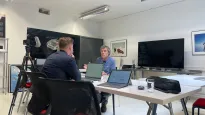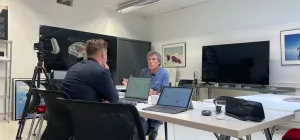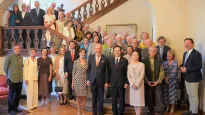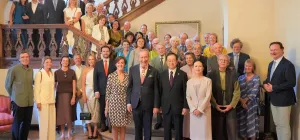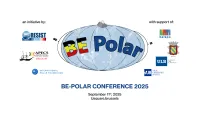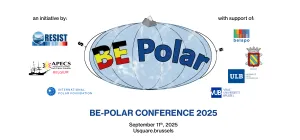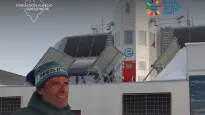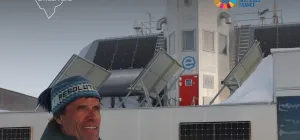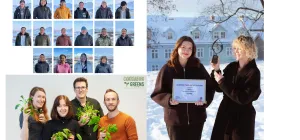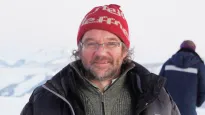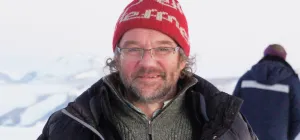MICROBIAN: The tiny life forms of Antarctica’s Sør Rondane Mountains

At first glance, the white frozen landscape of Antarctica appears devoid of any living thing, but if one takes a closer look at areas not covered by ice, it's teaming with tiny life forms
Background
Ice-free areas which are scarce but can be found scattered across East Antarctica, are amongst the most extreme terrestrial environments on Earth. Here, life is dominated by small microbes which somehow manage to survive these harsh conditions.
What shapes the biodiversity and biogeochemical processes of these tiny organisms provides a scientific basis for habitat mapping, developing conservation strategies, guiding long-term monitoring efforts and predicting the possible responses of these organisms to future environmental changes in Antarctica.
The MICROBIAN Project
Scientists from the University of Ghent and Liège University, Elie Verleyen, Sam Lambrechts and Valentina Savaglia, are now at Princess Elisabeth research station to discover more about this.
A previous expedition to Antarctica by their team revealed that many of the organisms living in the Sør Rondane Mountains are unique to the continent and so very special. Perhaps not really surprising considering these mountains encompass a diversity of terrestrial habitats which vary widely in geology and soil, exposure time and microclimatic conditions.
In fact, so little is known about the mountains near Princess Elisabeth that the area is a haven for scientists hoping to make new discoveries. And for Elie and his team, studying species which are highly adapted and possibly endemic to cold and dry environments are especially interesting for further research as these organisms could yield new insights into the cold and dry limits of life on earth.
Why choose Princess Elisabeth?
‘So far, most projects looking at microbial communities in Antarctica were done in coastal regions. Unlike many other research stations, Princess Elisabeth is about 200 km inland. This means that the ice-free regions around the station offer us a unique opportunity to study microbial communities in regions characterized by more extreme environmental and climatic conditions than those found in coastal ice-free oases.’ Prof. Dr. Elie Verleyen, Ghent University
Elie and his team will for the first time use high resolution satellite images to identify areas of special biological interest in East Antarctica. Among other things, they also plan to create an inventory of what microbes can be found, what factors determine their distribution and what effects climate change may have on them.
More broadly, the new knowledge they gain under the MICROBIAN project will make a significant contribution to our understanding of the ecology of Antarctica’s unique terrestrial microbes.
Meet the MICROBIAN Team
lie Verleyen has a PhD in Biology and works as a tenure track professor in the Protistology and Aquatic Ecology lab at Ghent University. He has expertise in the Late Quaternary ecology and evolution of polar and cold-temperate aquatic ecosystems, and in microbial biogeography and macroecology. He has played a significant role in the development of a network of reconstructions of Late Quaternary climate and relative sea level changes in East Antarctica and the sub-Antarctic islands. He has begun complementary work in the Arctic region, which will allow for a thorough understanding of the effects of climate change on the overall functioning and diversity of polar terrestrial ecosystems.
Sam Lambrechts is a PhD student based at the Laboratory of Microbiology of Ghent University. Trained as a biologist, Sam studies microbial biodiversity and ecology, with a focus on extreme environments, including polar and alpine ecosystems. His research on the recently discovered uncultivated majority, the so-called dark matter of microbiology, has highlighted how little we know about the diversity of microbes on this planet, this allowed him to discover how these are exciting times to be a microbial ecologist. In addition to his interest in microbiology, polar and alpine regions have unmistakably played a defining role in his life, triggering the same curiosity, continuous wonder and astonishment he experiences in scientific research.
Valentina Savaglia grew up in Sicily where she discovered the underwater world very early. For her, pursuing a career in ocean conservation was a natural progression. Fascinated by polar environments and intrigued by the adaptations living organisms need to survive such extreme environment, she found herself embarked to Carlini Station, in the Antarctic Peninsula. Here she decided to pursue studies on Antarctic ecology and is currently working on her Ph.D. at Liège University. As part of the MICROBIAN project, Valentina studies the biogeography, function and diversity of cyanobacteria in the Sør Rondane Mountains (East Antarctica), under the supervision of Dr. Annick Wilmotte and Dr. Elie Verleyen of Ghent University.
MICROBIAN is a project funded by BelSPO
Author: Lisa Benedetti
Download


